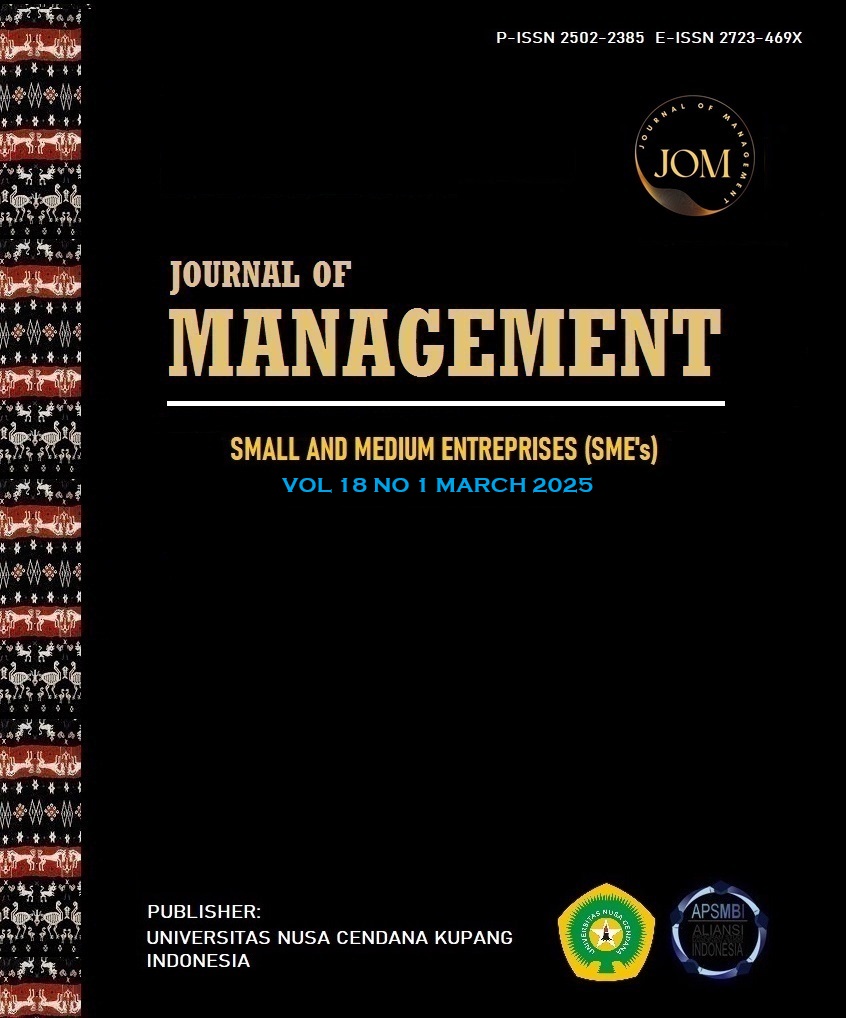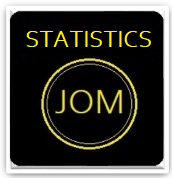CAN CRYPTOCURRENCY BE A HEDGE DURING CRISIS? A SYSTEMIC RISK POINT OF VIEW
Abstract
This study investigates the hedging possibilities of cryptocurrency assets using a systemic risk estimation approach during the COVID-19 crisis period. Using a quantitative research approach, the research uses S&P 500 index price data and cryptocurrency assets. The systemic risk is calculated by using the vine copula ΔCoVaR method and the APARCH-DCC approach on the portfolio of cryptocurrency assets calculated for both individual cryptocurrency assets and GMV portfolios to capture the non-linear and dynamic relationship between cryptocurrencies and other financial assets and to estimate the impact of risk induced by the asset portfolio on the index under extreme market conditions. As a result, in the short term, especially during the Covid-19 crisis, BTC is considered the first "safe haven," as it has minimal VaR, CoVaR, and ΔCoVaR both when estimated individually and in the form of a GMV portfolio. ETH and LTC take second and third place after BTC in terms of stability against global economic uncertainty.
Keywords: Cryptocurrency; Systemic Risk; Vine copula ΔCoVaR
Downloads
References
Akhtaruzzaman, M., Boubaker, S., Nguyen, D. K., & Rahman, M. R. (2022). Systemic risk-sharing framework of cryptocurrencies in the COVID–19 crisis. Finance Research Letters, 47(PB), 102787. https://doi.org/10.1016/j.frl.2022.102787
Akyildirim, E., Cepni, O., Corbet, S., & Uddin, G. S. (2023). Forecasting mid-price movement of Bitcoin futures using machine learning. Annals of Operations Research, 330(1–2), 553–584. https://doi.org/10.1007/s10479-021-04205-x
Ali, S., Naveed, M., Yousaf, I., & Khattak, M. S. (2024). From cryptos to consciousness: Dynamics of return and volatility spillover between green cryptocurrencies and G7 markets. Finance Research Letters, 60(October 2023), 104899. https://doi.org/10.1016/j.frl.2023.104899
Ali, S., Umar, M., Gubareva, M., & Vo, X. V. (2024). Extreme connectedness between NFTs and US equity market: A sectoral analysis. International Review of Economics and Finance, 91(February 2023), 299–315.
https://doi.org/10.1016/j.iref.2024.01.037
Arnell, L., Engström, E., Uddin, G. S., Hasan, M. B., & Kang, S. H. (2023). Volatility spillovers, structural breaks and uncertainty in technology sector markets. Financial Innovation, 9(1). https://doi.org/10.1186/s40854-023-00502-5
Barbu, T. C., Boitan, I. A., & Cepoi, C. O. (2022). Are cryptocurrencies safe havens during the COVID-19 pandemic? A threshold regression perspective with pandemic-related benchmarks. Economics and Business Review, 8(2), 29–49.
https://doi.org/10.18559/ebr.2022.2.3
Bedford, T., & Cooke, R. M. (2001). Probability density decomposition for conditionally dependent random variables modeled by vines. Annals of Mathematics and Artificial Intelligence, 32(1–4), 245–268.
https://doi.org/10.1023/A:1016725902970
Bedford, T., & Cooke, R. M. (2002). Vines - A new graphical model for dependent random variables. Annals of Statistics, 30(4), 1031–1068.
https://doi.org/10.1214/aos/1031689016
Betz, F., Hautsch, N., Peltonen, T. A., & Schienle, M. (2016). Systemic risk spillovers in the European banking and sovereign network. Journal of Financial Stability, 25, 206–224. https://doi.org/10.1016/j.jfs.2015.10.006
Bhuiyan, R. A., Husain, A., & Zhang, C. (2023). Diversification evidence of bitcoin and gold from wavelet analysis. Financial Innovation, 9(1), 1–36.
https://doi.org/10.1186/s40854-023-00495-1
Bouri, E., Das, M., Gupta, R., & Roubaud, D. (2018). Spillovers between Bitcoin and other assets during bear and bull markets. Applied Economics, 50(55), 5935–5949. https://doi.org/10.1080/00036846.2018.1488075
Bouri, E., Kamal, E., & Kinateder, H. (2023). FTX Collapse and systemic risk spillovers from FTX Token to major cryptocurrencies. Finance Research Letters, 56(April), 104099. https://doi.org/10.1016/j.frl.2023.104099
Bouri, E., Molnár, P., Azzi, G., Roubaud, D., & Hagfors, L. I. (2017). On the hedge and safe haven properties of Bitcoin: Is it really more than a diversifier? Finance Research Letters, 20, 192–198. https://doi.org/10.1016/j.frl.2016.09.025
Chen, Y., & Yu, W. (2020). Setting the margins of Hang Seng Index Futures on different positions using an APARCH-GPD Model based on extreme value theory. Physica A: Statistical Mechanics and Its Applications, 544, 123207.
https://doi.org/10.1016/j.physa.2019.123207
Chen, Y., Zhang, L., & Bouri, E. (2024). Co-Bubble transmission across clean and dirty Cryptocurrencies: Network and portfolio analysis. Journal of International Money and Finance, 145(May), 103108. https://doi.org/10.1016/j.jimonfin.2024.103108
Choueifaty, Y., & Coignard, Y. (2008). Toward maximum diversification. Journal of Portfolio Management, 35(1), 40–51. https://doi.org/10.3905/JPM.2008.35.1.40
Choueifaty, Y., Froidure, T., & Reynier, J. (2012). Properties of the Most Diversified Portfolio. SSRN Electronic Journal. https://doi.org/10.2139/ssrn.1895459
Conlon, T., Corbet, S., & McGee, R. J. (2020). Are cryptocurrencies a safe haven for equity markets? An international perspective from the COVID-19 pandemic. Research in International Business and Finance, 54(16).
https://doi.org/10.1016/j.ribaf.2020.101248
Corbet, S., Larkin, C., & Lucey, B. (2020). The contagion effects of the COVID-19 pandemic: Evidence from gold and cryptocurrencies. Finance Research Letters, 35(March), 101554. https://doi.org/10.1016/j.frl.2020.101554
Curto, J. D., & Serrasqueiro, P. (2022). The impact of COVID-19 on S&P500 sector indices and FATANG stocks volatility: An expanded APARCH model. Finance Research Letters, 46(PA), 102247. https://doi.org/10.1016/j.frl.2021.102247
Dai, X., Wang, Q., Zha, D., & Zhou, D. (2020). Multi-scale dependence structure and risk contagion between oil, gold, and US exchange rate: A wavelet-based vine-copula approach. Energy Economics, 88, 104774.
https://doi.org/10.1016/j.eneco.2020.104774
Deng, J., Zheng, H., & Xing, X. (2023). Dynamic spillover and systemic importance analysis of global clean energy companies: A tail risk network perspective. Finance Research Letters, 55(PB), 103990. https://doi.org/10.1016/j.frl.2023.103990
Duan, H., Yu, J., & Wei, L. (2024). Measurement and Forecasting of Systemic Risk: A Vine Copula Grouped-CoES Approach. Mathematics, 12(8).
https://doi.org/10.3390/math12081233
Dyhrberg, A. H. (2016). Bitcoin, gold and the dollar - A GARCH volatility analysis. Finance Research Letters, 16, 85–92. https://doi.org/10.1016/j.frl.2015.10.008
Elsayed, A. H., Naifar, N., Uddin, G. S., & Wang, G. J. (2023). Multilayer information spillover networks between oil shocks and banking sectors: Evidence from oil-rich countries. International Review of Financial Analysis, 87(May 2022), 102602. https://doi.org/10.1016/j.irfa.2023.102602
Engle, R. F., & Sheppard, K. (2001). Theoretical and Empirical properties of Dynamic Conditional Correlation Multivariate GARCH. Working Paper, 1–46.
Fang, F., Ventre, C., Basios, M., Kanthan, L., Martinez-Rego, D., Wu, F., & Li, L. (2022). Cryptocurrency trading: a comprehensive survey. Financial Innovation, 8(1). https://doi.org/10.1186/s40854-021-00321-6
Feng, W., Wang, Y., & Zhang, Z. (2018). Can cryptocurrencies be a safe haven: a tail risk perspective analysis. Applied Economics, 50(44), 4745–4762.
https://doi.org/10.1080/00036846.2018.1466993
Feng, Y., Wang, G. J., Zhu, Y., & Xie, C. (2023). Systemic risk spillovers and the determinants in the stock markets of the Belt and Road countries. Emerging Markets Review, 55(May 2022), 101020. https://doi.org/10.1016/j.ememar.2023.101020
Girardi, G., & Tolga Ergün, A. (2013). Systemic risk measurement: Multivariate GARCH estimation of CoVaR. Journal of Banking and Finance, 37(8), 3169–3180. https://doi.org/10.1016/j.jbankfin.2013.02.027
Granger, C. W. J., & Engle, F. (1995). A long memory property of stock market returns and a new model. Journal of Empirical Finance, 2(1), 98.
https://doi.org/10.1016/0927-5398(95)90049-7
Hedström, A. P., Uddin, G. S., Rahman, M. L., & Sjö, B. (2024). Systemic risk in the Scandinavian banking sector. International Journal of Finance and Economics, 29(1), 581–608. https://doi.org/10.1002/ijfe.2699
Hoque, M. E., Billah, M., Alam, M. R., & Tiwari, A. K. (2024). Gold-backed cryptocurrencies: A hedging tool against categorical and regional financial stress. Global Finance Journal, 60(August 2023), 100964. https://doi.org/10.1016/j.gfj.2024.100964
Hsu, S. H., Cheng, P. K., & Yang, Y. (2024). Diversification, hedging, and safe-haven characteristics of cryptocurrencies: A structural change approach. International Review of Financial Analysis, 93(March), 103211.
https://doi.org/10.1016/j.irfa.2024.103211
Kayral, I. E., Jeribi, A., & Loukil, S. (2023). Are Bitcoin and Gold a Safe Haven during COVID-19 and the 2022 Russia–Ukraine War? Journal of Risk and Financial Management, 16(4). https://doi.org/10.3390/jrfm16040222
Kumar, S., Sureka, R., Lucey, B. M., Dowling, M., Vigne, S., & Lim, W. M. (2024). MetaMoney: Exploring the intersection of financial systems and virtual worlds. Research in International Business and Finance, 68, 102195.
https://doi.org/10.1016/j.ribaf.2023.102195
Le Thi Thuy, V., Oanh, T. T. K., & Ha, N. T. H. (2024). The roles of gold, US dollar, and bitcoin as safe-haven assets in times of crisis. Cogent Economics and Finance, 12(1). https://doi.org/10.1080/23322039.2024.2322876
Li, L., & Miu, P. (2023). Are cryptocurrencies a safe haven for stock investors? A regime-switching approach. Journal of Empirical Finance, 70(December 2022), 367–385. https://doi.org/10.1016/j.jempfin.2022.12.010
Li, L., & Tu, Y. (2022). The varying spillover of U.S. systemic risk: A functional-coefficient cointegration approach. Economics Letters, 212.
https://doi.org/10.1016/j.econlet.2022.110306
Mba, J. C. (2024). Assessing portfolio vulnerability to systemic risk: a vine copula and APARCH-DCC approach. Financial Innovation, 10(1).
https://doi.org/10.1186/s40854-023-00559-2
Moutari, D. N., Mallam, H. A., Barro, D., & Saley, B. (2021). The ARMA-APARCH-EVT models based on HAC in Dependence Modeling and Risk Assessment of a Financial Portfolio. European Journal of Pure and Applied
Mathematics, 14(4), 1467–1489. https://doi.org/10.29020/nybg.ejpam.v14i4.4114
Nan, S., Wang, M., You, W., & Guo, Y. (2023). Making text count: Identifying systemic risk spillover channels in the Chinese banking sector using annual reports text. Finance Research Letters, 55(PA), 103901. https://doi.org/10.1016/j.frl.2023.103901
Pangestuti, R. S. (2019). the Effect of Credit and Liquidity Risk Against Systemic Risk in Four Asean Banks. JIAFE (Jurnal Ilmiah Akuntansi Fakultas Ekonomi), 4(1), 1–8. https://doi.org/10.34204/jiafe.v4i1.1072
Scaillet, O., Treccani, A., & Trevisan, C. (2018). High-Frequency Jump Analysis of the Bitcoin Market. SSRN Electronic Journal. https://doi.org/10.2139/ssrn.2982298
Shahzad, S. J. H., Arreola-Hernandez, J., Bekiros, S., Shahbaz, M., & Kayani, G. M. (2018). A systemic risk analysis of Islamic equity markets using vine copula and delta CoVaR modeling. Journal of International Financial Markets, Institutions and Money, 56, 104–127. https://doi.org/10.1016/j.intfin.2018.02.013
Sklar, M. (2023). Fonctions de répartition à N dimensions et leurs marges To cite this version : HAL Id : hal-04094463. 3, 229–231.
Stocks, N. (2016). 済無No Title No Title No Title.
Stolbov, M., & Shchepeleva, M. (2024). 15 years of research on systemic risk across the globe: The evolution of the field and its drivers. Research in Globalization, 8(August 2023), 100195. https://doi.org/10.1016/j.resglo.2024.100195
Stolbov, M., Shchepeleva, M., & Parfenov, D. (2024). The systemic risk-uncertainty-real economic activity nexus: What is beyond median estimation? Economics Letters, 235(November 2023), 111550. https://doi.org/10.1016/j.econlet.2024.111550
Wei, Z., He, Q., Zhou, Q., & Wang, G. (2023). Measuring dependence structure and extreme risk spillovers in stock markets: An APARCH-EVT-DMC approach. Physica A: Statistical Mechanics and Its Applications, 632(P1), 129357. https://doi.org/10.1016/j.physa.2023.129357
Woitschig, P., Uddin, G. S., Xie, T., & Härdle, W. K. (2023). The Energy Consumption of the Ethereum-Ecosystem. SSRN Electronic Journal.
https://doi.org/10.2139/ssrn.4526732
Xie, Q., Qin, J., & Li, J. (2023). Are the systemic risk spillovers of good and bad volatility in oil and global equity markets alike? Energy Strategy Reviews, 49(September), 101191. https://doi.org/10.1016/j.esr.2023.101191
Xu, M., Chen, X., & Kou, G. (2019). A systematic review of blockchain. Financial Innovation, 5(1). https://doi.org/10.1186/s40854-019-0147-z
Yousaf, I., Arfaoui, N., & Gubareva, M. (2024). Spillovers and hedging effectiveness between oil and US equity sectors: Evidence from the COVID pre- and post-vaccination phases. Research in International Business and Finance, 69(September 2022), 102204. https://doi.org/10.1016/j.ribaf.2023.102204
Yousaf, I., Youssef, M., & Gubareva, M. (2024). Return and volatility spillovers between non-fungible tokens and conventional currencies: evidence from the TVP-VAR model. Financial Innovation, 10(1). https://doi.org/10.1186/s40854-023-00570-7
Zhang, P., Lv, Z. X., Pei, Z., & Zhao, Y. (2023). Systemic risk spillover of financial institutions in China: A copula-DCC-GARCH approach. Journal of Engineering Research (Kuwait), 11(2). https://doi.org/10.1016/j.jer.2023.100078
Zhang, X., Yang, X., & He, Q. (2022). Multi-scale systemic risk and spillover networks of commodity markets in the bullish and bearish regimes. North American Journal of Economics and Finance, 62(April 2021), 101766.
https://doi.org/10.1016/j.najef.2022.101766
Zhao, M., Lu, S., & Cui, L. (2024). Measurement, identification, and spillover effects of systemic risk in the international clean energy market. Energy Strategy Reviews, 52(February 2023), 101355. https://doi.org/10.1016/j.esr.2024.101355
Zhu, B., Deng, Y., Lin, R., Hu, X., & Chen, P. (2022). Energy security: Does systemic risk spillover matter? Evidence from China. Energy Economics, 114(September), 106252. https://doi.org/10.1016/j.eneco.2022.106252

 Rinda Siaga Pangestuti(1*)
Rinda Siaga Pangestuti(1*)



